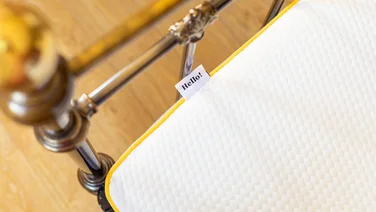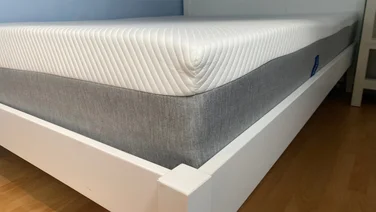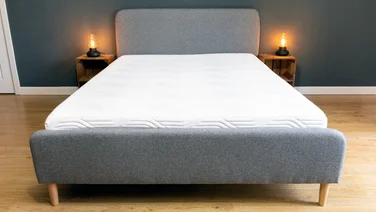To help us provide you with free impartial advice, we may earn a commission if you buy through links on our site. Learn more

If you want to know how to get rid of bed bugs, then you’re most likely already dealing with an infestation. The first step is to remain calm as bed bugs aren’t dangerous, nor do they carry diseases. That’s the good news – the bad news is that these hugely irritating insects love nothing more than to feast on your blood while you sleep. And despite the name, you will also find them attached to your clothing, furniture, mattresses and other personal effects.
More good news – bed bugs are tiny. They’re roughly the size of an apple seed, and only really grow to around 6mm in length. Of course, this means it’s easy for them to fit into the smallest crevices around your room – in your bed itself or in the cracks in your wall, the skirting boards and the plug sockets. They nap during the day and sneak out at night to do what they do best (bite you).
The key to getting rid of bed bugs is in knowing your enemy. Below, we’ve outlined everything you need to know about the minuscule menaces, and then explained exactly how to get rid of them, including reviews and links to our favourite bed bug-removal products.
Without further ado, here’s how to get rid of bed bugs.
Best ways to get rid of bed bugs: At a glance
| Best bed bug traps | Zero In Bed Bug Traps (~£6.99) | |
| Best bed bug spray | PestShield Bed Bug Killer (~£8.99) | |
| Best travel solution | Pyramid Premium Bed Bug Sheet & Pillow Cases (~£21) |
How to get rid of bed bugs
A quick entomology lesson
“Female bed bugs can lay 200 to 500 eggs over two months in batches of 10 to 50,” says Kathryn Shaw of the British Pest Control Association. “The eggs are sticky and attach to items of furniture or fittings in clusters. Depending on conditions, eggs can hatch in about a week, and then those females can reproduce again in around six weeks. If you don’t deal with an infestation promptly, it will grow out of control.”
What’s more, because bed bugs can crawl long distances, they can spread like wildfire around your home. They particularly like fabrics and wood but can also be found everywhere from the edges of carpets to behind wall-mounted pictures.“It’s essential to be aware that they typically don’t inhabit outdoor spaces,” adds Lyuben Kiryakov, co-director of Bed Bug Specialist. “This means bed bugs usually enter a property through infested luggage or items. Infestations often arise after visits to places like hotels, hostels and airbnbs – locations where they are commonly found. People can even inadvertently transport bed bugs into their homes from places like airport luggage departments.”
Scarier still, even if bed bugs don’t get access to your blood, they can survive for up to a year, which makes eradicating them all the more difficult.
Here are a few common misconceptions:
• Bed bugs only live in dirty homes: Because they survive on blood alone, the reality is you’re just as likely to find them in spotless homes.
• Bed bugs nest: Unlike ants and bees, these insects don’t have nests, but they do find common hiding places, so you are likely to find them in groups.
• Bed bugs only live in your bed: Of course, they love beds because it means easy access to your blood. However, once they start spreading you can find them anywhere in your home.
• It hurts when bed bugs bite: Although they have to pierce your skin to access your blood – which they feed on for several minutes, accessing any area of the body they can find – they do this mainly while you’re sleeping. You only feel discomfort when the bites turn into itchy marks or lumps later (not that that’s a whole lot of comfort).
How can I prevent bed bugs?
- Check any second-hand bedroom furniture (especially beds and bedside cabinets) thoroughly before bringing it into your home.
- Avoid buying second-hand mattresses.
- Inspect your mattress and bed regularly.
- Keep your bedroom clutter-free to cut down on their hiding places.
If you think you’ve stayed in an infested room, check everything you have with you (including all luggage and clothing) for bugs, using the advice below. Ideally, wash all your clothes on a hot (60˚C) cycle. Alternatively, dry clean all your clothes or put them in a freezer for at least three days to kill all the bugs off.
How can I tell if I have an infestation of bed bugs?
Look out for these tell-tale signs:
- You wake up with itchy bites you didn’t have the night before – these often appear in straight lines on your body.
- You recently bought a used bed or other used furniture when these bites started.
- Tiny blood stains on your sheets or pillowcase.
- Small dark or rusty spots of dried bed-bug poo on your sheets, pillowcase, mattress (don’t forget to look on the underside) or other areas around your home, including the walls.
- Signs of shed skin (tiny mottled bug-shaped exoskeletons) on the carpet, under the bed and in “difficult to clean” areas.
- Tiny white eggs are visible in the crevices and joints of your mattress and furniture – you may need a torch to find them.
- A musty smell in your bedroom.
I have a bed bug infestation: What next?
1. Wash all the fabrics in the relevant rooms – including bedding, clothing and curtains – on a high setting (ideally 60˚C) and/or put them in a tumble drier on a hot setting for half an hour.
“Washing bedding and clothes in hot water (at least 60˚C/140˚F) kills bed bugs at all stages of their life cycle,” says Lyuben. “The hot water disrupts their cell membranes and proteins, eventually killing them.”
2. Scrub all surrounding areas, especially around your bed, with a stiff brush, then vacuum thoroughly to suck up the bugs, getting rid of the sealed bag outside immediately. Don’t forget the walls, paintings and all furniture – and pay special attention to bed and furniture legs, carpet edges and door or window frames.
“While vacuuming doesn’t kill bed bugs, it removes them from the living space,” Lyuben explains. “Emptying the vacuum contents into a sealed plastic bag and disposing of it outside prevents the bugs from scurrying back into your home.”
3. Apply a chemical bed bug treatment (spray or steamer) to all the areas mentioned above, taking care to use a product that’s safe for bedrooms and bedding. See below for specific mattress cleaning instructions. Be sure to check if, and how often, you need to reapply the treatment.
“Steaming is one of the best DIY and professional methods to exterminate bed bugs and their eggs,” says Lyuben. “When you use a steamer on areas where bed bugs hide, the high temperature effectively kills them by denaturing their proteins and dehydrating them.”
4. Repair cracks in the plaster or wallpaper to seal up favourite bed bug hiding places.
5. Keep the area around your bed as clear as possible. Consider using bed bug traps under furniture legs and the bed frame.
6. If you feel overwhelmed by the infestation, call in professional help. Contact your local council or a pest control firm that’s a member of the British Pest Control Association or National Pest Technicians Association. They will carry out an inspection, then use a special treatment such as insecticide, a steamer or rapid freeze system to get rid of the bugs.
“Seeking professional help for dealing with bed bugs is always the best approach,” advises Lyuben. “Professional-grade products used by exterminators are safer, more potent and not accessible to the general public. Plus, professional exterminators have the expertise to identify all potential hiding spots for bed bugs in your home more accurately.
“It’s important to note that allowing the infestation to grow before seeking professional help can make the bed bug problem more challenging and costly to eliminate. Acting promptly can help prevent the infestation from spreading and becoming more entrenched in your home.”
How do I treat my mattress for bed bugs?
If your mattress is heavily infested, consider buying a new one. Just ensure you tackle the surrounding areas first, or the bed bugs will simply move from the old mattress to the replacement. Cover the mattress with plastic before disposing of it.
If you want to treat your mattress and keep it, spray an aerosol can of bed bug treatment (like PetShield Bed Bug Killer, below) directly onto the mattress. Focus on the seams, tufts and folds and don’t worry about the mattress getting damp – just allow it to dry.
Alternatively, use a bed bug steamer (your local pest control firm should be able to recommend a suitable model) to steam your mattress, bed and surrounding areas.
Now use insecticide dust on both the mattress and box springs. This treatment lasts for several months and reaches tricky-to-get-to areas like mattress corners.
Next, cover your mattress with a bed bug-proof mattress cover or bed bug mattress encasement to stop bed bugs entering or escaping for at least a year. It’s the only way to ensure they are all dead. Do the same with a “box spring encasement” for your box spring bed base. If you don’t cover them, you’ll need to reapply your bed bug treatment every 7-10 days until you don’t see any further bed bug activity.
You can now reapply your bedding, as long as it’s been washed at a high temperature and run through a tumble dryer on high heat.
READ NEXT: Best mattresses
How to get rid of bed bugs: Our favourite products
1. Zero In Bed Bug Traps: Best bed bug traps

Price when reviewed: £6.99 (pack of 5) | Check price at Amazon
Not quite sure if you have bed bugs? Traps can be your best bet in finding out, acting as an early indicator that you have an infestation. They’re also good if you’ve had a bed bug nightmare and want to prevent future problems. Since these ones are poison and chemical-free for up to two months, you don’t need to worry about inhaling anything toxic – and they catch bed bugs at both the immature and mature stages quickly. Once you find bed bugs in the trap, follow our tips above promptly or call in the professionals.
Key specs – Dimensions (WDH): 8.6 x 2.4 x 14.5cm; Weight: 30g
2. PestShield Bed Bug Killer: Best bed bug spray

Price when reviewed: £8.99 (pack of 3) | Check price at Amazon
You get three cans in this pack, which is a good job as, with a bad infestation, you’ll need to keep spraying and re-spraying as we’ve outlined above. Don’t spray the bedding and bed linen – that needs to be washed at high temperatures. Instead, save the spray for the mattress, headboard, springs, base and every area you can around the bed, including carpets, skirting boards, walls, bedside cabinets and elsewhere. The mattress will take the longest because you’ll need to focus on seams, tufts and folds, as well as the surface. We found this product to be more effective than other similar sprays on the market and it doesn’t produce a nasty odour either.
Key specs – Package dimensions (WDH): 19.2 x 5.3 x 21.5cm; Capacity: 200ml (per can); Weight: 690g
3. Pyramid Premium Bed Bug Sheet & Pillow Cases: Best travel solution

Price when reviewed: £21 | Check price at Amazon
Worried about bed bugs when you’re staying elsewhere? This lightweight and easily transportable sheet and pillow-case combo is made from a tough polyester netting similar to the kind used in mosquito nets. It’s a valuable extra line of defence against bugs when travelling, and it packs down into a small pouch when not in use for easy transportation. Both the sheet and the pillow cases are also treated with a permethrin impregnation (an insecticide used to treat scabies and lice) that kills any insects on contact and will last for up to two years or 35 washes.
Key specs – Double sheet:150 x 200cm (WD); Pillows: (not stated); Weight: 290g










